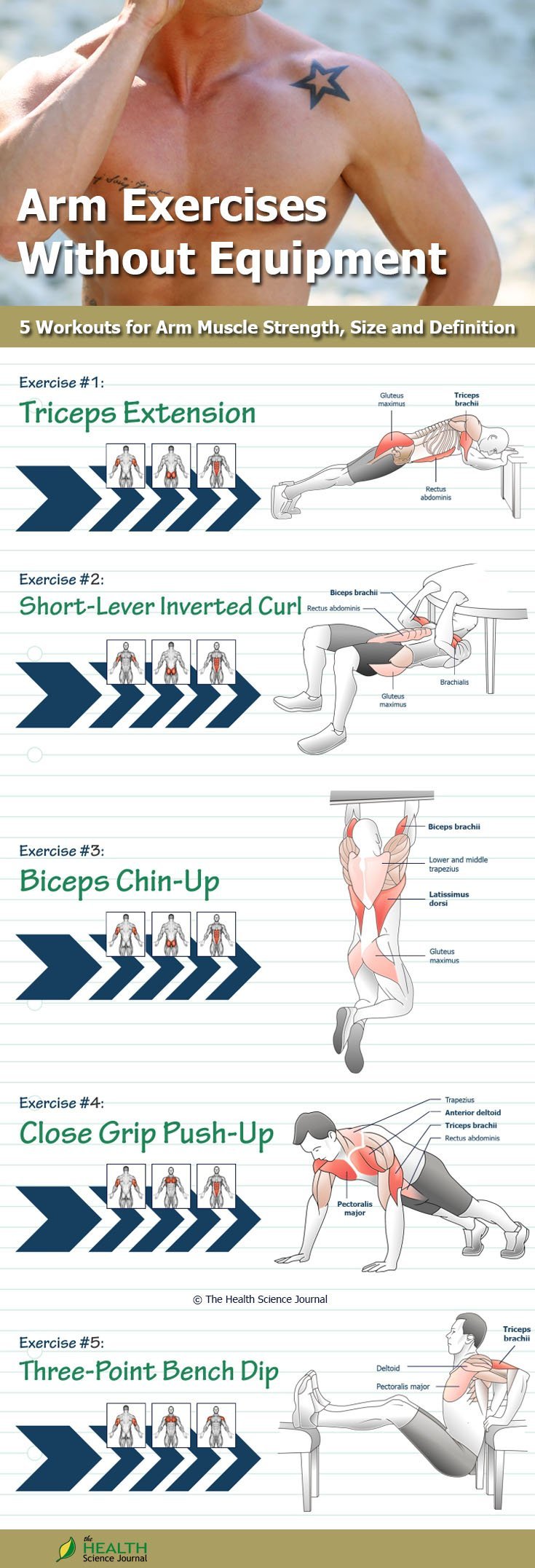Everybody wants to have good looking arms. Guys want well developed arms, while women want them slender and toned. Together with abs, arms are some of the most exercised parts of the body. It’s no accident – when worked upon, arms can look very impressive. We invite you to stay put as we present our top bodyweight tricep exercises and favourite bodyweight bicep exercises. We’ll also show you how to get bigger arms at home. You won’t need any special equipment besides some furniture that can be found in most homes.
Bodyweight Exercises
Bodyweight training is the most convenient type of resistance – all you need is your own body, and you’ll never be without equipment or a facility. You can gain tremendous functional fitness in terms of strength, power, balance, endurance and flexibility from progressive bodyweight training – all from the convenience of your own home.
We have taken upon the task of creating a series where we’ll demonstrate the best bodyweight exercises and show you the most effective way to combine them into cohesive programs consistent with your fitness goals. We started with this 10 Level Push-Up Challenge which uses various modifications of the classical push up to progressively build up upper body strength and will continue with separate programs for specific parts of the body, beginning with the arms.
By following our bodyweight series, you will have the tools to become lean, limber, and athletic. You won’t be intimidated by push ups and pull ups and your glutes will function like never before. Daily tasks requiring physical effort will become a breeze and the confidence you’ll gain from this program will shine through in all aspects of your life.
You’ll save thousands on gym membership fees without compromising the quality of your workout. By using these savings to make healthier food choices, you can get even better results from your training.
Many people wonder if they can develop impressive muscularity and fitness solely by performing bodyweight exercises. The answer is a definitive YES. As you progress to more difficult variations and increase the number of repetitions your body will respond by synthesizing more protein and laying down more muscle tissue. With these bodyweight tricep and bicep exercises you’ll learn how to manipulate your body to achieve a world-class workout. You do not need to be a slave to the gym. Make the world your gym and become its resistance!
Bicep and Tricep Muscles
Among men, well-built biceps and triceps are probably the most desired muscles of the body. When teenage boys join the gym, the first thing they usually ask about is arm training. This is understandable, as arms are the least covered part of the body. While clothes conceal most of the torso and legs, the arms are usually in plain view for everyone to see.
However, arm exercises are important for both women and men. The benefits they bring are universal and the looks are equally attractive. Many women are insecure about the appearance of their arms, the triceps in particular, and seek to develop the area by strengthening exercises. In fact, while the biceps seem to get all the glory, the appearance of the arms requires proper development of the triceps, as well. One can even claim that, in function and esthetic appeal, the triceps is the most important muscle of the upper arms.
Before we start with our bodyweight tricep and bicep exercises, let’s first try to better understand the arm musculature. The primary elbow flexors are the biceps brachii (see picture below), which are moving the wrist toward the shoulder by bending the arm. Other elbow flexors, like the brachialis and brachioradialis, contribute to movement in varying degrees depending on how the elbow flexion exercise is performed (for example, which grip is used).

Figure 2.1 Biceps brachii, brachialis, and brachioradialis (source Wikipedia)
The primary elbow extensors are the triceps brachii, consisting of three heads — the long head, medial head, and lateral head (see picture below), which are moving the wrist away from the shoulder, straightening the arm from shoulder to wrist.

Figure 2.2 Triceps brachii (source Wikipedia)
The arms are essential most athletic pursuits. The elbow extensors are heavily used in sports, from baseball, golf, American football, volleyball, and basketball to boxing and track and field. The flexors are relied on in tennis, boxing, mixed martial arts, rowing, when tackling in football, and when pulling the body up in rock climbing. In everyday life, you are using them when carrying heavy objects out in front of the body.
Bodyweight Tricep and Bicep Exercises
The arms are worked substantially during all upper body exercises that involve the effort of more than two joints at the same time. This is why every time you train your chest, shoulders, and back you’ll be also working your arms. This is especially important in bodyweight training as multi-joint movements will be the most productive in terms of total muscular output.
Interestingly, since you’ll be working your chest as well as your arms, you may notice bigger growth in your pectoralis major than your upper arm. Also, the triceps will be easier to make bigger in the beginning and more difficult afterwards. Do not be alarmed, you aren’t doing anything wrong. This is because of the different time course of the muscle hypertrophic response between the upper arm and chest.
It is crucial when performing arm exercises to concentrate on squeezing the targeted muscles and not allow other muscles to take over the job. Concentrate on feeling the arm muscles contracting when creating the desired movement. Before training his biceps, Arnold Schwarzenegger used to envision them growing as big as mountains. Bodybuilders call it a mind–muscle connection and with time you will also develop these neuromuscular pathways. When performing the following bodyweight tricep and bicep exercises start by thinking about your training. Visualize yourself contracting your muscles against resistance. This will help you put maximal stress on the intended muscles and help you build bigger arms at home.
Bodyweight Tricep Exercises: Triceps Extension

Safety tip: choose a stable, sturdy table, or chair.
EXECUTION
- Place your hands on the edge of a table/chair and lean your body into a push-up position. Make sure your grip is correct – fingers straight in front of you;
- Keep your body in a straight line with straight arms and legs and weight on the toes. Pull-in and tense your abdominals, brace your glutes and start lowering your body by bending the elbows;
- Focus on raise your body by using the triceps to extend the elbows.
MUSCLES INVOLVED
Primary: Triceps brachii
Secondary: Rectus abdominis, gluteus maximus
NOTES
We start with the triceps extension as it is one of the rare exercises that truly targets the triceps. The reason is that the body revolves around the elbow joint with almost pure elbow extension. Plant firmly into the ground and contract the abdominals and glutes to maintain a solid straight line from head to toe, similar to a plank or a push-up. Maintain the position throughout the exercise. Be careful not to bend your hips as this can be potentially harmful to the low back. Keep the shoulder joint fixed and try to contain most of the movement around the elbows. Focus on using the triceps muscles to raise and lower the body.
You can control the difficulty level of this exercise by adjusting the height of your support. Using a taller chair or table makes the exercise easier. To make the exercise more difficult, use a shorter chair or table.
VARIATION: Short-Lever Triceps Extension
Individuals who find this movement challenging may perform the movement from the knees, limiting the body weight being lifted. Try funding a sturdy chair or coffee table for support, as a standard table is too high.
Bodyweight Bicep Exercises: Short-Lever Inverted Curl
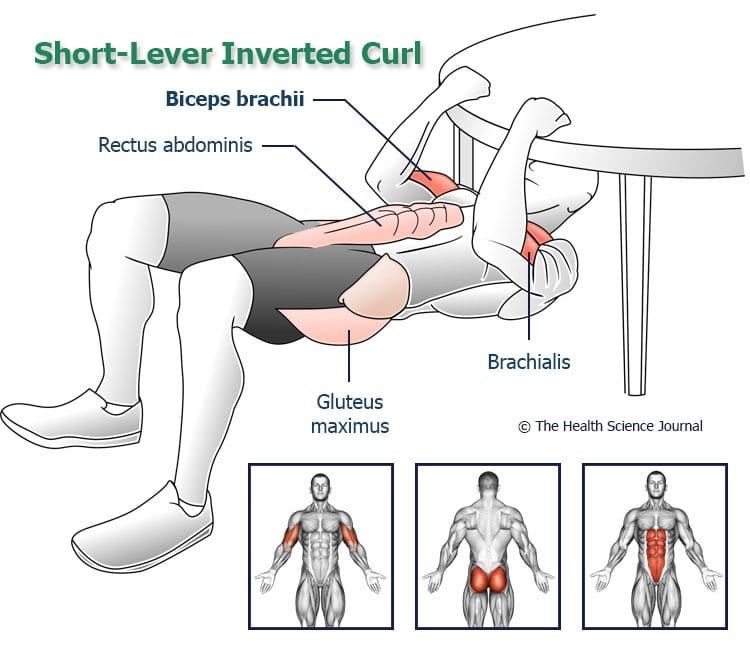
Safety tip: choose a sturdy table or chair and preferably perform over a soft surface (carpeting).
EXECUTION
- With your back on the floor, set up under a sturdy table with your hands grasping the outer edges, palms facing each other;
- Keep the torso and legs in a straight line, neck in neutral position, knees bent at 90 degrees, weight on the heels and the abs and glutes braced. Now raise your body by bending the elbows and keeping your head and neck in their natural positions, not tilted up or back;
- Keeping the shoulder joints fixed, lower to starting position by moving mostly at the elbows.
MUSCLES INVOLVED
Primary: Biceps brachii
Secondary: Brachialis, rectus abdominis, gluteus maximus
NOTES
Note that the short-lever inverted curl is one of the rare pure biceps exercises, as most of the others will heavily involve the muscles of the back. As in the previous exercise, make sure you tense and contract the core and the glutes in order to keep your torso and legs in a straight line. This maintains core stability while moving your body around the elbows to target the biceps.
As with our other bodyweight triceps and biceps exercises, try to increase the difficulty (load) as you go on. You can again accommodate different levels of strength by using a taller table (easier), or a shorter table (more challenging). Depending on the type of table you use for support, you might not be able to get a full range of motion, as your head might come into contact with the bottom of the table. If this is indeed the case, just execute an isohold by holding the top position for some time (30 seconds to 2 minutes) or perform a shorter-range pumping motion. Otherwise, grip both ends of a towel wedged into the top of a door. By using a neutral grip you can work the brachialis and brachioradialis a bit more than the biceps.
VARIATION: Long-Lever Inverted Curl
Individuals who find the movement easy may perform the exercise with straight legs that are elevated on to another chair or bench, increasing the total body weight being lifted.
Bodyweight Bicep Exercises: Biceps Chin-Up
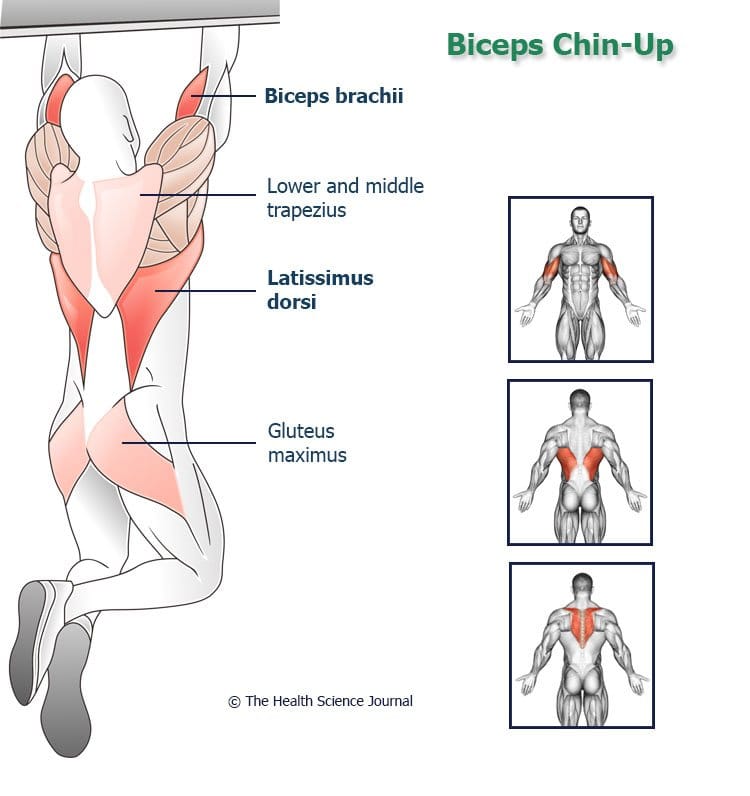
Safety tip: use a secure rafter or chin-up bar.
EXECUTION
- Start in a full-stretch position, hanging from a secure rafter or a chin-up bar with straight arms and a supinated grip, palms facing you. The toes are off the ground and the knees can be somewhat bent or straight, depending on what is more comfortable;
- In a slow and steady manner, pull your body over the rafter/ bar to sternum height while maintaining a stable core;
- Equally steady, lower your body all the way down to the starting position.
MUSCLES INVOLVED
Primary: Biceps brachii, latissimus dorsi
Secondary: Brachialis, lower and middle trapezius, rhomboids, rectus abdominis, gluteus maximus
NOTES
The chin-up is a classic bodyweight exercise for the biceps and back muscles (latissimus dorsi). This movement requires a rafter or bar you can hang from with a supinated grip – which works best for the biceps.
This exercise is commonly done incorrectly as people fail to use the full range of motion at the top and bottom of the movement, by swinging the legs and using momentum, overarching their low back, or by shrugging their shoulders at the top of the movement.
You must maintain a stable core and keep your body in a straight line, from the shoulders to the knees, with tensed and contracted abs and braced glutes. When at the very top of the movement with the chin over the bar, keep the shoulder blades back and down, tucked into the back pockets. Maintain a full range of motion by starting from a fully hanging position and keep rising all the way to where the bar touches the top of your chest. By performing chin-ups in this manner, you’ll get an effective core workout in addition to the upper-body workout.
Bodyweight Tricep Exercises: Close Grip Push-Up
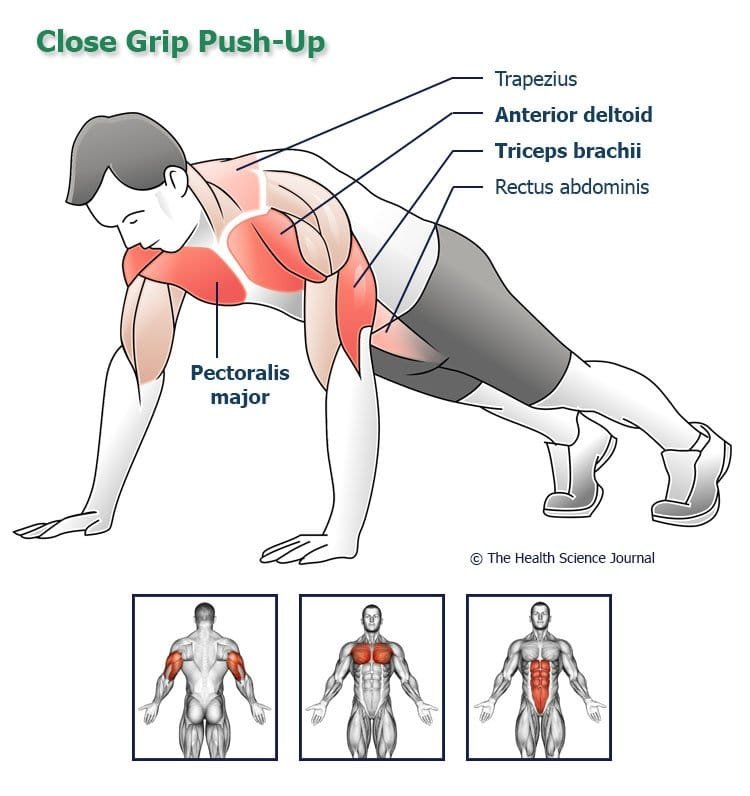
EXECUTION
- Lie in a normal push-up position with your face down and the hands positioned shoulder-width apart, the elbows tucked into the body;
- With the feet together, braced glutes and a stable core, press the body up;
- Lower the body until the chest touches the floor.
MUSCLES INVOLVED
Primary: Triceps brachii, pectoralis major, anterior deltoid
Secondary: Upper and lower trapezius, serratus anterior, rectus abdominis, gluteus maximus
NOTES
The close grip push-up is another classic exercise that targets the triceps and pectorals. While the exercise is extremely effective, you must maintain a high level of concentration to perform the correct movement. Most people are either sagging at the hips, looking up and overextending the neck, stopping short and failing to use a full range of motion, or, crucially for the triceps, failing to center their elbows over the wrists. Continuous flexion of the abs and glutes ensures a strong core, keeping the body straight and not allowing the hips to sag. Make sure you lower your body until the chest touches the floor. Look down throughout the exercise and keep checking that the elbows are in line with the wrists. Again, keeping your muscles tensed and contracted ensures you get a good core workout in addition to the upper-body workout.
VARIATION: Diamond Grip Push-Up
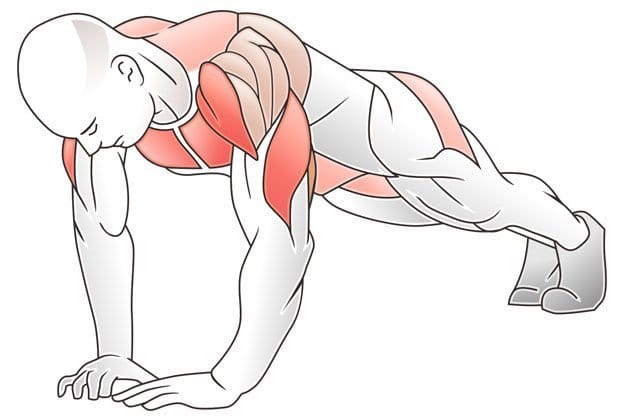
The diamond grip push-up is more challenging than the close grip push-up as it relies more heavily on the triceps. Perform this variation with the hands touching each other on the floor by forming a diamond shape with the thumbs and index fingers.
Bodyweight Tricep Exercises: Three-Point Bench Dip
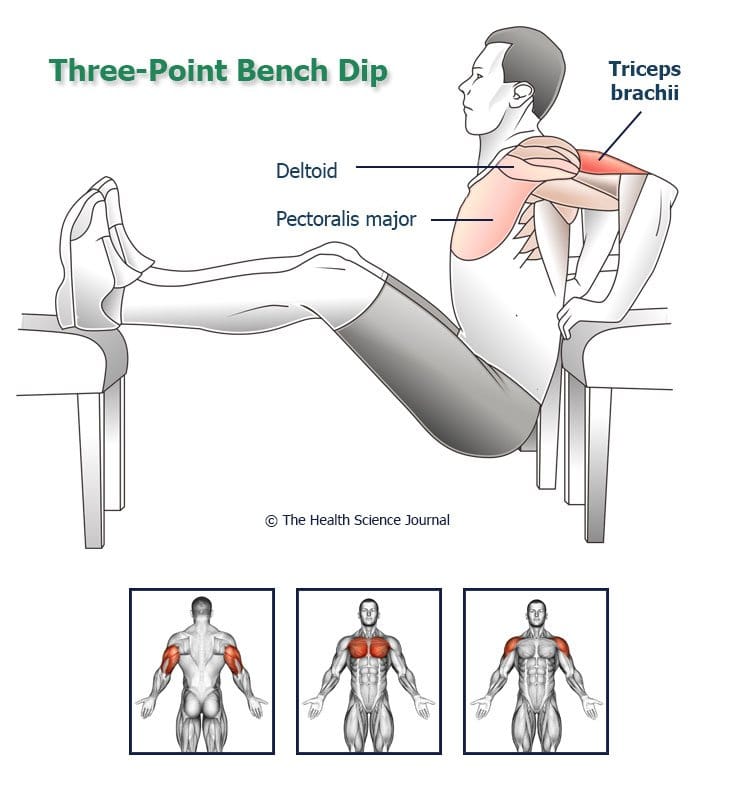
Safety tip: use sturdy chairs or weight benches.
EXECUTION
- You can use either 3 chairs or, if you have access to them, two weight benches. Set up the three chairs so that your feet are resting on one and your torso is centered between the other two. You can set the benches parallel to each other, with your palms on one bench and your heels on the other;
- Place the palms on the end of each of the 2 chairs, the fingers forward, and keep your torso upright and the legs in a straight line. Progressively lower your body until you feel an adequate stretch. Don’t go too low, you’ll be risking an injury. When your upper arms become parallel to the floor you know you’ve gone far enough;
- Push your body back up to the starting position.
MUSCLES INVOLVED
Primary: Triceps brachii
Secondary: Pectoralis major, anterior deltoid
NOTES
The bench dip is a common exercise performed at most gyms. It’s an effective triceps builder and you can easily adjust the difficulty depending on your strength level. You can make it easier by performing with the feet flat on the floor and knees bent, reducing the total amount of body weight being lifted. Descend only until your upper arms become parallel to the floor to receive a good stretch. Be warned though: if you regularly lower yourself too deeply, you put the soft tissue and structure around the shoulder joint at risk of an injury. Keep a tall chest and a straight neck throughout the movement and don’t allow the lower back to round.
How to Get Bigger Arms at Home in 4 Weeks (Infographic)
We used our bodyweight triceps and biceps exercises to create an infographic about a 4-week workout on how to get bigger arms at home. While the results will be visible in 4 weeks or even less, true results will appear after 15-25 weeks of progressive load increasing exercises.

REFERENCES:
http://www.health.com/fitness/8-ways-to-amp-up-your-bodyweight-workout
http://www.mensfitness.com/training/build-muscle/9-best-bodyweight-moves-develop-colossal-arms
http://www.webmd.com/fitness-exercise/news/20060726/arms-shoulders-ache-try-exercise
https://www.hght.com/sermorelin/sermorelin-weight-loss/
https://en.wikipedia.org/wiki/Triceps_brachii_muscle


